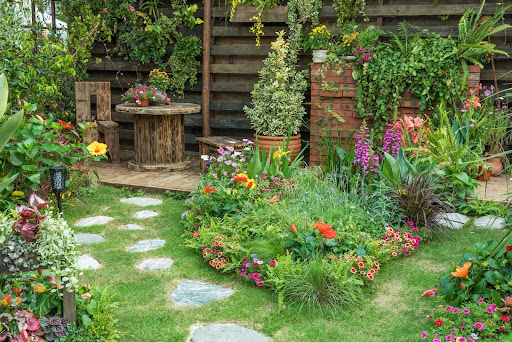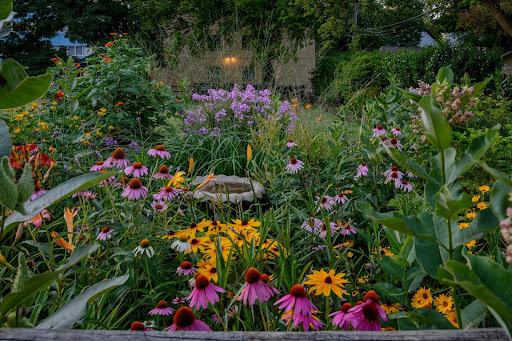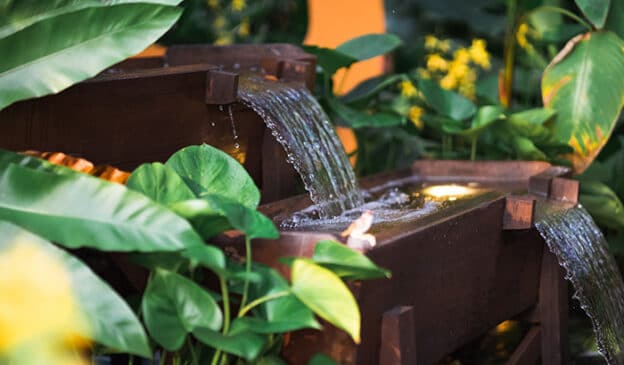Eco-friendly practices in garden design are more than a trend; they create sustainable, healthy environments that benefit us and the planet.
Sustainable garden design focuses on creating outdoor spaces that harmonize with the local ecosystem, use resources efficiently, and reduce their environmental impact. This approach to landscaping is about more than planting a few trees; it’s about creating a garden that thrives naturally, supports local wildlife, and minimizes its ecological footprint.
In this guide, we’ll explore how to incorporate sustainable practices into your garden design. From selecting the right plants and materials to implementing water-saving techniques and organic maintenance methods, we’ll provide practical tips to make your landscape beautiful and environmentally responsible.
Whether you’re a seasoned gardener or barely starting, these eco-friendly strategies will help you create a garden that’s a joy to behold and a boon to the earth.
The principles of sustainable garden design
A sustainable garden design seeks to create a harmonious balance between your landscaping desires and the natural ecosystem. It’s about making conscious choices that benefit the environment, promote biodiversity, and reduce your ecological footprint. This gardening methodology goes beyond aesthetics, focusing on practices that sustain and enhance the health of your landscape and the surrounding environment.
At its core, sustainable garden design involves selecting plants native to your region, which are more likely to thrive with minimal intervention. It also means using organic methods to enrich the soil, conserving water through smart irrigation practices, and choosing environmentally friendly and locally sourced materials. This approach reduces the need for chemical fertilizers and pesticides, conserves natural resources, and provides habitat for local wildlife.
By adopting sustainable garden design principles, you’re creating a beautiful space for yourself and contributing to the environmental health of your region. You’re helping to preserve local plant species, support pollinators, and reduce pollution and waste. Sustainable garden design is a way to give back to the earth while enjoying the beauty and tranquility of your outdoor space.

Planning your sustainable garden
Planning your sustainable garden is a journey that begins with understanding and respecting the natural landscape around you. It’s about creating a beautiful space that functions in harmony with nature.
Here are steps to plan an eco-friendly garden:
Site analysis
Start by observing your garden area throughout the day. Take note of how sunlight, shade, and wind patterns change. Understanding these elements helps you decide the best placement of plants, water features, and seating areas. Also, consider the natural slope of your land to manage water flow and reduce erosion.
Choosing native plants
Native plants are the cornerstone of sustainable gardening. They are adapted to your local climate and soil conditions and require less water, fertilizer, and care than non-native species. They also provide essential habitat and food for local wildlife, including birds, bees, and butterflies. Research the native plants of your region and choose a mix that will thrive in your garden’s specific conditions.
Considering wildlife
Plan your garden to be a haven for wildlife. Incorporating elements like bird feeders, native flowering plants, and water sources turns your garden into a thriving ecosystem. Avoid using pesticides and herbicides, as these can harm the local fauna.
Importance of soil health
Healthy soil is the foundation of a sustainable garden. Conduct a soil test to understand its type and nutrient levels. Use organic matter like compost to improve soil health, supporting plant growth and increasing water retention.
Organic gardening practices
Embrace organic gardening practices to maintain your garden. This includes using natural pest control methods, organic fertilizers, and composting. These practices keep your garden healthy and ensure it remains a safe space for you, your family, and the environment.
By following these steps, you create a sustainable garden that is both a personal sanctuary and a contribution to the local ecosystem. Remember, sustainable gardening is a continuous learning process and adapting to work alongside nature.
Water conservation strategies
In sustainable garden design, water conservation is a key element. By implementing smart strategies, you can significantly reduce water usage in your garden, benefiting both the environment and your water bill. Here are some effective techniques:
Drip irrigation
This system delivers water directly to the roots of your plants, minimizing evaporation and runoff. It’s more efficient than traditional sprinkler systems because it reduces water wastage and helps your plants get the perfect amount of moisture they need.
Rainwater harvesting
Collecting rainwater is an excellent way to reduce reliance on tap water for your garden. Use rain barrels or a more complex system to capture rainwater from your roof and use this water for irrigation to make your garden self-sufficient and eco-friendly.
Appropriate plant selection
Choose plants that are well-suited to your local climate and soil conditions. Native plants and drought-resistant varieties require less water and are more likely to thrive in your garden.
Mulching
Applying a layer of mulch around your plants helps retain soil moisture, reducing the need for frequent watering. Mulch also suppresses weeds and adds organic matter to the soil as it decomposes.
Soil management
Healthy soil retains water more effectively. Incorporate organic matter into your soil to improve its structure and water-holding capacity. Regularly check soil moisture levels to ensure you’re watering only when necessary.
Adopting these water conservation strategies makes your garden more sustainable and creates a more resilient landscape.
Eco-friendly plant selection
Selecting the right plants is important for creating an eco-friendly garden. By focusing on native and drought-resistant varieties, you ensure your garden is beautiful and sustainable.
Choosing native and drought-resistant plants
Native plants are those that are originally from your region. They are adapted to local climate and soil conditions, making them more resilient and easier to care for. These plants require less water and are less susceptible to local pests and diseases, reducing the need for chemical interventions.
Drought-resistant plants, similarly, are designed to thrive in low-water conditions. They are ideal for sustainable gardens, especially in regions prone to water scarcity.
Benefits of biodiversity and planting for pollinators
Biodiversity is vital for a healthy ecosystem. A diverse range of plants not only creates a more visually appealing garden but also supports a variety of wildlife.
Planting for pollinators (such as bees, butterflies, and birds) is particularly important. These creatures play a crucial role in pollinating many plants and crops. By including flowering plants that provide nectar and pollen, you create a haven for these essential species, contributing to the health of the local ecosystem.
Incorporating native, drought-resistant, and pollinator-friendly plants into your garden design is a powerful step toward creating a more sustainable and eco-friendly landscape. This approach benefits the environment and creates a vibrant and dynamic garden for you to enjoy.

Sustainable garden maintenance
Maintaining a sustainable garden requires a commitment to eco-friendly practices, especially in pest control, soil enrichment, and lawn care. By adopting organic methods, you keep your garden healthy and contribute to the broader environmental well-being.
Organic pest control methods
Instead of relying on chemical pesticides, consider natural alternatives. Introduce beneficial insects, like ladybugs, which feed on common garden pests such as aphids. Planting herbs like lavender and basil also helps repel unwanted insects. Opt for barriers and humane traps rather than pesticides to protect your garden from larger pests.
Composting and natural fertilizers
Composting is a cornerstone of sustainable gardening. Turn kitchen scraps and garden waste into compost to create a rich, organic fertilizer that nourishes your plants and improves soil health. This reduces waste while also replacing the need for chemical fertilizers.
Additionally, natural fertilizers like bone meal and fish emulsion provide essential nutrients to your plants.
Eco-friendly lawn care tips
For a sustainable lawn, choose a mix of grass suited to your local climate to reduce water and maintenance needs. Mow your lawn at a higher setting to encourage deeper root growth, which helps the grass withstand drought and reduces the need for frequent watering. Leave grass clippings on the lawn as a natural fertilizer, and aerate your lawn periodically to improve water absorption and reduce runoff.
Incorporating renewable energy in your garden
In today’s eco-conscious world, incorporating renewable energy into your garden design is not simply a trend but a meaningful step towards sustainability. One of the most accessible and effective ways to do this is through solar-powered lights and water features.
Solar-powered lights
These are a fantastic way to illuminate your garden paths, highlight key features, and create a warm ambiance without increasing your carbon footprint. Solar lights are easy to install, as they don’t require wiring, and they harness energy from the sun during the day to provide outdoor lighting at night. This saves water and reduces electricity costs.
Solar-powered water features
Similarly, solar-powered fountains and water features add a dynamic element to your garden without needing electrical wiring. They operate by using solar panels to power the pump, creating a sustainable and tranquil water display that enhances the beauty of your garden.
The benefits of using renewable energy sources in garden design are manifold. They reduce greenhouse gas emissions, promote energy independence, and offer a cost-effective solution to powering your garden features.
Upgrade your lawn or garden with LaytonScape
If you’re looking to bring these eco-friendly principles to life in your landscape, LaytonScape is your go-to expert. As a renowned Utah landscaping company, we specialize in creating stunning, sustainable outdoor environments. Whether you’re planning a new garden or revamping an existing one, our team at LaytonScape has the expertise and passion to help you achieve your landscaping goals.
Contact LaytonScape today to start your journey towards a more sustainable, beautiful, and thriving landscape.



